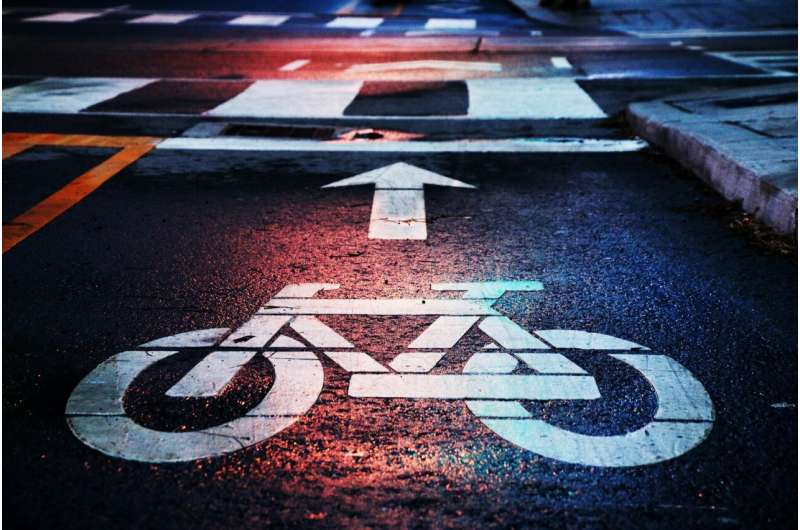
A new analysis from University of Toronto Engineering researchers leverages machine learning to help answer a thorny question: where should new protected bike lanes be placed to provide maximum benefit?
"Right now, some people have really good access to protected biking infrastructure: they can bike to work, to the grocery store or to entertainment venues," says Madeleine Bonsma-Fisher, a postdoctoral fellow in the Department of Civil & Mineral Engineering and lead author of a new paper published in the Journal of Transport Geography.
"More lanes could increase the number of destinations they can reach, and previous work shows that will increase the number of cycle trips taken.
"However, many people have little or no access to protected cycling infrastructure at all, limiting their ability to get around. This raises a question: is it better to maximize the number of connected destinations and potential trips overall, or is it more important to focus on maximizing the number of people who can benefit from access to the network?"
Bonsma-Fisher and her team—including her co-supervisors, Professors Shoshanna Saxe and Timothy Chan, and Ph.D. student Bo Lin—use machine learning and optimization to help inform such decisions. It's a challenge that required new computational approaches.
"This kind of optimization problem is what's called an NP-hard problem, which means that the computing power needed to solve it scales very quickly along with the size of the network," says Saxe.
"If you used a traditional optimization algorithm on a city the size of Toronto, everything would just crash. But Ph.D. student Bo Lin invented a really cool machine learning model that can consider millions of combinations of over 1,000 different infrastructure projects to test what are the most impactful places to build new cycling infrastructure."
Using Toronto as a stand-in for any large, automobile-oriented North American city, the team generated maps of future bike lane networks along major streets, optimized according to two broad types of strategies.
The first, which they called the utilitarian approach, focused on maximizing the number of trips that could be taken using only routes with protected bike lanes in under 30 minutes—without regard for who those trips were taken by.
The second, which they termed equity-based, aimed to maximize the number of people who had at least some connection to the network.
"If you optimize for equity, you get a map that is more spread out and less concentrated in the downtown areas," says Bonsma-Fisher.
"You do get more parts of the city that have a minimum of accessibility by bike, but you also get a somewhat smaller overall gain in average accessibility."
"There is a trade-off there," says Saxe.
"This trade-off is temporary, assuming we will eventually have a full cycling network across the city, but it is meaningful for how we do things in the meantime and could last a long time given ongoing challenges to building cycling infrastructure."
Another key finding was that there are some routes that appeared to be essential no matter what strategy was pursued.
"For example, the bike lanes along Bloor West show up in all of the scenarios," says Saxe.
"Those bike lanes benefit even people who don't live near them and are a critical trunk to maximizing both the equity and utility of the bike network. Their impact is so consistent across models that it challenges the idea that bike lanes are a local issue, affecting only the people close by. Optimized infrastructure repeatedly turns out in our model to serve neighborhoods quite a distance away.
The team is already sharing their data with Toronto's city planners to help inform ongoing decisions about infrastructure investments. Going forward, the team hopes to apply their analysis to other cities as well.
"No matter what your local issues, or what choices you end up making, it's really important to have a clear understanding of what goals you are aiming for and check if you are meeting them," says Bonsma-Fisher.
"This kind of analysis can provide an evidence-based, data-driven approach to answering these tough questions."
More information: Madeleine Bonsma-Fisher et al, Exploring the geographical equity-efficiency tradeoff in cycling infrastructure planning, Journal of Transport Geography (2024). DOI: 10.1016/j.jtrangeo.2024.104010
Citation: Machine learning analysis sheds light on who benefits from protected bike lanes (2024, October 15) retrieved 15 October 2024 from https://techxplore.com/news/2024-10-machine-analysis-benefits-bike-lanes.html
This document is subject to copyright. Apart from any fair dealing for the purpose of private study or research, no part may be reproduced without the written permission. The content is provided for information purposes only.
